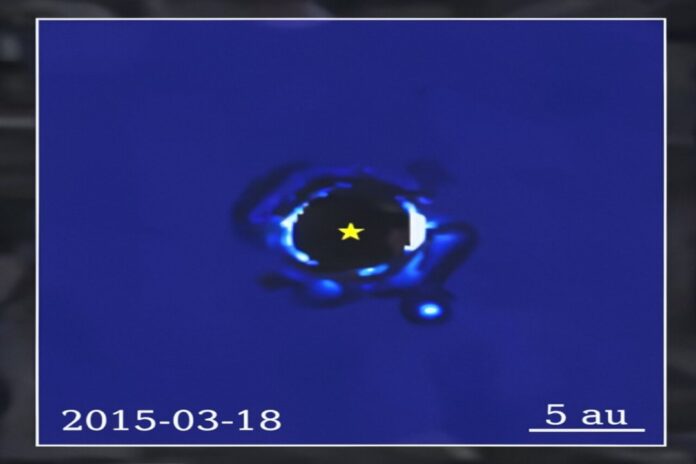A Northwestern University astrophysicist has created the longest time-lapse video of an exoplanet to date.
Constructed from real data, the footage shows Beta Pictoris b—a planet 12 times the mass of Jupiter—sailing around its star in a tilted orbit. The time-lapse video condenses 17 years of footage (collected between 2003 and 2020) into 10 seconds. Within those seconds, viewers can watch the planet make about 75% of one full orbit.
“We need another six years of data before we can see one whole orbit,” said Northwestern astrophysicist Jason Wang, who led the work. “We’re almost there. Patience is key.”
An expert in exoplanet imaging, Wang is an assistant professor of physics and astronomy in Northwestern’s Weinberg College of Arts and Sciences and member of the Center for Interdisciplinary Exploration and Research in Astrophysics (CIERA). Late last year, Wang unveiled a 12-year time-lapse video (below) of a family of four exoplanets orbiting their star.
Credit: Jason Wang/Malachi Noel
Beta Pictoris b is an enormous planet, located about 63 light-years from Earth in the constellation Pictor. The distance between Beta Pictoris b and its star (Beta Pictoris) is about 10 times the distance between the Earth and the sun. Compared to our sun, Beta Pictoris is 1.75 times as massive and 8.7 times more luminous. It also is very young—only 20 to 26 million years old.
When Beta Pictoris b was first imaged in 2003, its size and brightness made it easier to spot, compared to other exoplanets.
“It’s extremely bright,” Wang said. “That’s why it’s one of the first exoplanets to ever be discovered and directly imaged. It’s so big that it’s at the boundary of a planet and a brown dwarf, which are more massive than planets.”
Credit: Northwestern University
Wang began tracking the exoplanet years ago, constructing his first time-lapse footage of the system to show five years of its journey. For the updated, longer version of the time-lapse, Wang sought help from Malachi Noel, a student at New Trier High School in Winnetka, Illinois. Noel spent summer 2022 as a member of CIERA’s Research Experiences in Astronomy at CIERA for High School Students (REACH) program. Then, as a REACH graduate, Noel began working under Wang’s mentorship during January 2023.
Noel used AI-driven image-processing techniques to uniformly analyze archival imaging data from three instruments—one at the Gemini Observatory and two at the European Southern Observatory. After Noel uniformly processed the data, Wang then used an algorithmic technique called motion interpolation to fill in gaps to create a continuous video. Otherwise, the exoplanet would jump around instead of smoothly orbiting through space.
“If we just combined the images, the video would look really jittery because we didn’t have continuous viewing of the system every day for 17 years,” Wang said. “The algorithm smooths out that jitter, so we can imagine how the planet would look if we did see it every day.”
“Due to the long time-range, there was a lot of diversity among the datasets, which required frequent adaptations to the image processing,” Noel said. “I really enjoyed working with the data. While it is too early to know for sure, astrophysics is definitely a career path I am seriously considering.”
To assemble the video, Wang also used technology called “adaptive optics” to correct image blurring caused by Earth’s atmosphere and specialized instrumentation to suppress the glare of the system’s central star. (This is why the video has a black circle surrounding a cartoon star icon in the center.)
Even with these techniques, the star’s glare is still so intense that it outshines the exoplanet when it gets too close. For those sections, Wang marked the briefly unobservable exoplanet with an “x,” so viewers can trace its path.
Wang hopes his exoplanet videos give viewers a glimpse into planetary motion and an admiration of the universe’s inner workings.
“A lot of times, in science, we use abstract ideas or mathematical equations,” Wang said. “But something like a movie—that you can see with your own eyes—gives a visceral kind of appreciation for physics that you wouldn’t gain from just looking at plots on a graph.”
To assemble the video, Wang used data from the Gemini Observatory’s Gemini Planet Imager and the European Southern Observatory’s NACO and SPHERE instruments.
